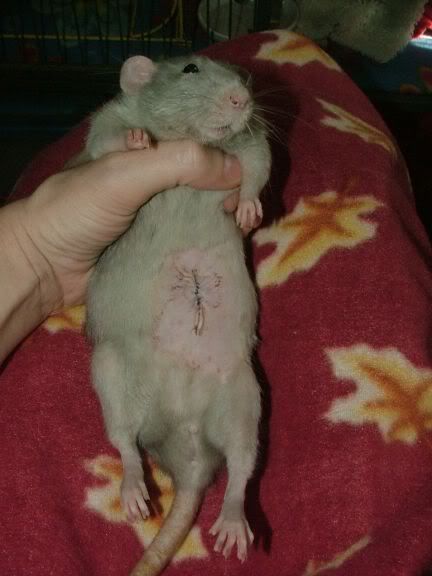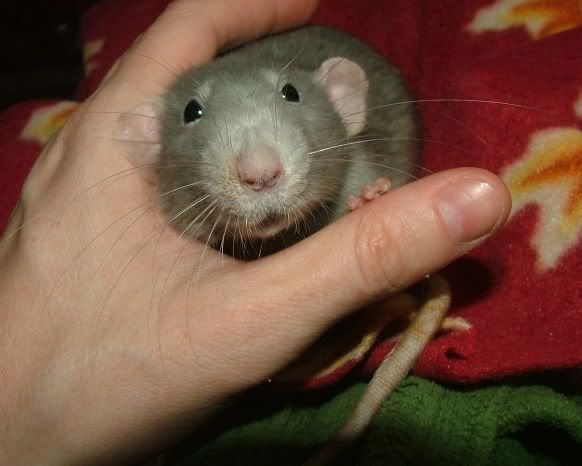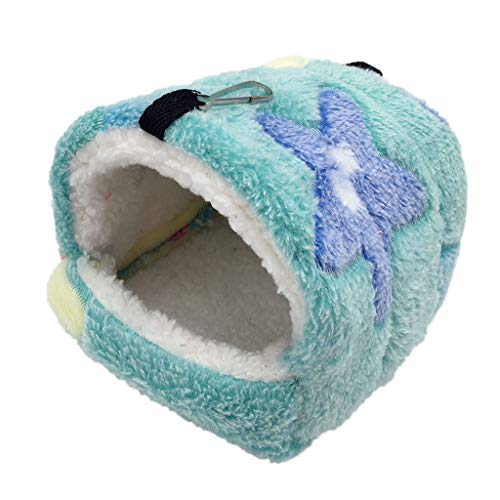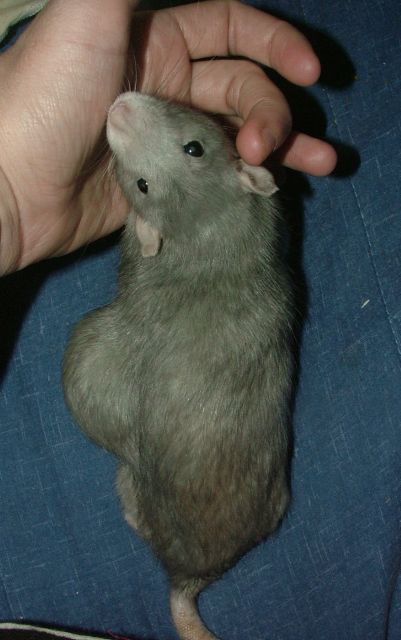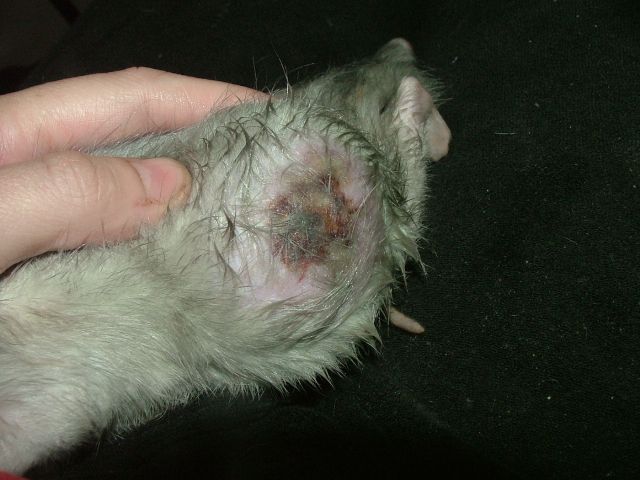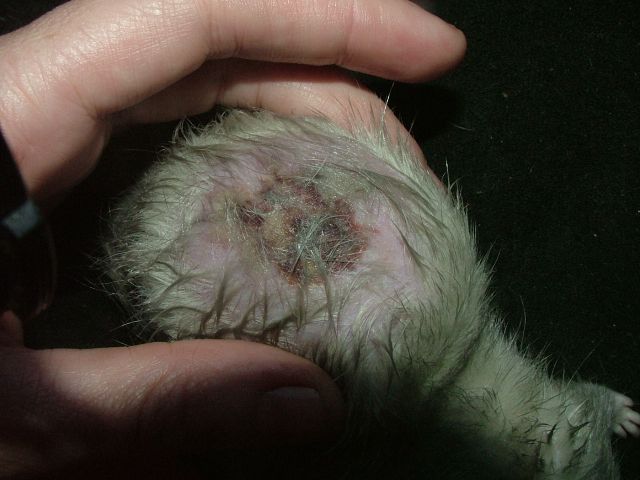Aha! Found this
In the author's experience, the best method for treating abscesses of the head of rabbits involves complete (or as nearly complete as possible) excision of the abscess and filling the defect with antibiotic impregnated polymethyl methacrylate (AIPMMA) beads. The abscess is removed as completely as possible and the defect is filled with AIPMMA beads which release relatively high concentration of antibiotic locally with little systemic absorption. The rabbit is still placed on systemic antibiotics for 2 weeks but long term therapy is not necessary as the beads release antibiotic for many months. The antibiotic chosen is based on culture and sensitivity results. Where there is no growth, a broad spectrum antibiotic with activity against P. multocida is selected. The beads are left in place a minimum of 2 months at which time they may be removed assuming there is no recurrence of abscessation. If the beads are not removed, they do not cause clinical problems as they are biologically inert. Indications for removal are the presence of a fistulous tract, poor cosmetic results, and interference with normal function. If they are placed within a mucosal lined cavity such as the nasal cavity, their presence will stimulate production of a serous exudate and removal is indicated. For purposes of removal, it is ideal to place the beads on an orthopedic wire when making them, forming a string of beads. In this manner when the beads are to be removed the surgeon need only locate one bead and the remainder can be removed by pulling the string. Unfortunately, when used in rabbit head abscesses, the beads are often too small to string on an orthopedic wire making bead removal more challenging.
Antibiotic Impregnated Polymethyl Methacrylate Beads AIPMMA has been used in human medicine since the early 1970's for the treatment and prevention of infection. Since that time it has been used for a variety of soft tissue and orthopedic problems. In veterinary medicine, it has most commonly been used for total hip arthroplasty to decrease the incidence of osteomyelitis associated with the procedure; however it has also been used to treat cellulitis in a bear, chronic sinorhinitis in cats, and open fractures and septic arthritis in horses. The author has also had positive results with it in treating septic arthritis and osteomyelitis in reptiles and birds. The rationale behind the use of AIPMMA is to provide high local concentration of antibiotic with low systemic absorption and, therefore, less toxicity. It is useful in infections where long-term use or the systemic use of the antibiotic of choice would be contraindicated. This is often the case with rabbit abscesses. It is useful in intractable patients where it is difficult to administer systemic antibiotic with the required frequency. And it is useful when an expensive antibiotic is indicated as repeated administration is not required. It is NOT indicated for treatment of systemic infections.
The ideal antibiotic for use in AIPMMA beads is one that is bacteriocidal, broad spectrum, effective in low concentration, heat stable (up to 100o C), and has high water solubility and low tissue toxicity. Gentamicin has been studied extensively and has been shown to elute concentrations above the break point susceptibility concentration for over 80 days with levels detectable for over 5 yrs. The average serum concentration (1 g gentamicin/20 g PMMA) was only 0.5 mcg/ml and the wound fluid concentration was 80 mcg/ml. These studies were conducted using powdered gentamicin which is not available in medical grade. Many use tobramycin at the same concentration as it is available in a powder. Recent research conducted by the author indicates there is no difference in elution between the powdered gentamicin and the liquid form used clinically. The formulation and amount of antibiotic can affect the strength of the PMMA but that is not of concern when making beads as they are not under stress.
Antibiotics commonly used where elution information is available include the following: gentamicin or tobramycin (1g/20g PMMA) and cephalothin or cefazolin (2g/20g PMMA). The author has recently conducted studies with amikacin and ceftiofur. It appears that amikacin (1.25g/20g PMMA) and ceftiofur (2g/20g PMMA) also elute at effective rates and concentrations. This data has not been fully analyzed at this point, however. In our work, there was no difference in elution between powdered and liquid gentamicin; however, there was a difference in the elution rate between liquid and powdered amikacin. The liquid form eluted slower than the powder.
The elution of the antibiotic is bimodal with a rapid release in the first few days followed by a slow, long term release of antibiotic over weeks to months. The beads become encapsulated with fibrous tissue within a few weeks and then only tissues within about 3 mm receive the high concentration of antibiotic. Because of this it is essential to remove the abscess as completely as possible before placing the beads. They should not be placed within the abscess capsule. The rate of elution is affected by various factors. The amount of fluid flowing past the beads influences the rate such that highly vascular areas elute the antibiotic more rapidly with more systemic absorption and more rapid depletion of the antibiotic within the beads. When placing beads in vascular tissues a higher concentration of antibiotic may be necessary than when placing beads in less vascular tissue such as bone. The head of rabbits tends to be made up of relatively well vascularized tissue, but the author has not increased the concentration of antibiotics. The diffusion properties of the antibiotic and its heat stability also affect elution rates. The exothermic polymerization reaction can denature antibiotics such as penicillins making them less effective. These drugs can be used but in higher concentrations. The previously mentioned antibiotics are heat stable. Enrofloxacin is not heat stable. Until elution studies have been conducted it is not recommend that new antibiotics be used clinically. Combining antibiotics also may change elution rates in unexpected ways and is not recommended.
Another factor influencing elution rates is the shape of the beads. These are not commercially available and must be made by the veterinarian. They may be made at the time of surgery aseptically and implanted immediately or made preoperative, sterilized with ethylene oxide, and stored for future use. The shelf life for these beads is unknown but assumed to be the normal expiration date of the antibiotic. Because the fumes are annoying and potentially damaging to contact lenses, many prefer to make the beads in a hood prior to surgery. The cement comes in 20 and 40 g packets (Surgical Simplex; Howmedica, Rutherford, NJ or Bone Cement; Zimmer, Patient Care Division, Charlotte, NC) which is enough to treat several rabbit abscess. Any unused beads are gas sterilized and used in future patients. The antibiotic is mixed THOROUGHLY with the copolymer powder prior to adding the liquid monomer. With some antibiotics this takes several minutes. Once the polymerization begins, the cement hardens within 10 minutes. Refrigerating the reagents prior to use will extend this time. It can be challenging to make all the beads that quickly and the aid of an assistant is very helpful. Beads may be rolled into spheres and strung on a fine gauge wire. A sphere has the most surface area which increases elution. A rough surface also has more surface area. Unfortunately, the size of bead that can physically be made with the fingers is often too large for use in rabbit abscesses. As an alternative, the mixture is placed in a syringe (catheter tip for larger beads and regular tip for small beads) and squirted out onto a paper surface (such as a table drape intraoperative). A scalpel is then used to cut the tube of cement into small pieces. In this manner, a group of small cylinders will be created to function as beads. These beads will be too small to string on a wire. When placing the beads, count the number implanted and record it in the patient record.
Complications associated with the beads are few. Superinfections due to long term antibiotic use have not been reported. There are no reports of allergic reactions to the antibiotics eluted from the beads. There have been no reports of systemic toxicity from the antibiotics either. Elution, however, can vary and with potentially toxic antibiotics such as gentamicin and penicillin (in rabbits) care is taken to make sure that an excess dose is not delivered systemically by placing too many beads with a high concentration of antibiotic.
